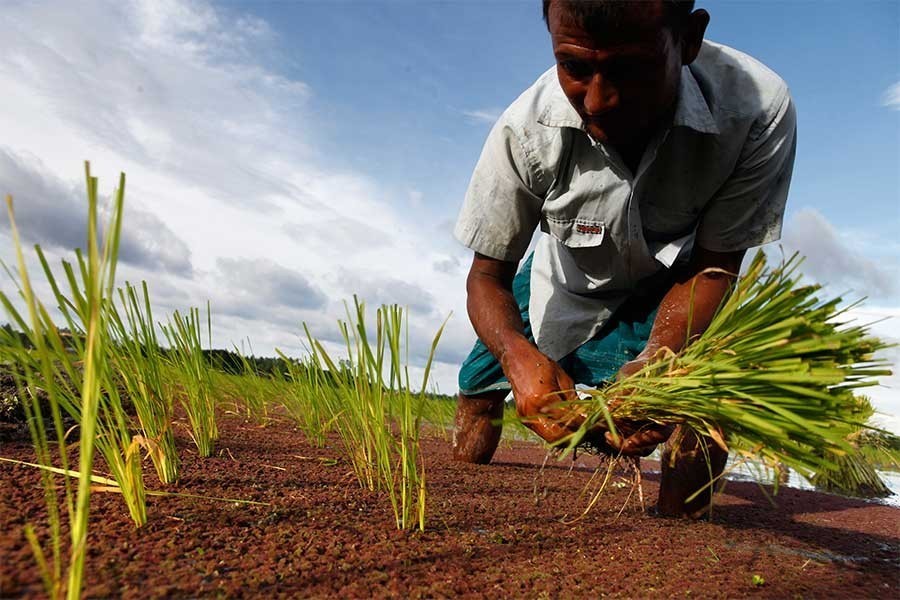Historically the role of agriculture in economic development has been described in terms of food production for people, supply of raw materials to industries, employment generation for the poor, foreign exchange earnings, so on and so forth. The fear of the Malthusian spectre of famine added another feather to its prominence of lifting society out of the shadow of famine through increased availability of food. Availability was synonymous with access to or entitlements. To this effect, for most of the 20th century, agricultural concerns around the world, particularly in Bangladesh, cantered around increasing food production (by hook or by crook) for addressing food shortage leading to famine. The advent of the Green Revolution luckily greased the wheel and the country is out of the shadow of famine.
No wonder that in grappling with agricultural growth, research and policy interest broadly bypassed the linkages between agriculture and nutrition. But since early 2010s, agriculture-nutrition research received attention with the realisation that self-sufficiency in food grain production may not necessarily translate into nutritional improvement. The classic example is between Sub-Saharan Africa and South Asia where the former outpaced the latter in terms of nutritional achievements although not in the growth rate of agricultural production.
The International Food Policy Research (IFPRI) very recently (2019) brought out the book, Agriculture for Improved Nutrition: Seizing the Momentum. Comprised of 18 chapters written by different researchers with multi-dimensional discussions relating to agriculture-nutrition linkages, this book was edited by Shenggen Fan, Sivan Yosef, and Rajul Pandya-Lorch - all from IFPRI. While an avalanche of literature are now available on the linkages, "this book focuses on the developments in agriculture and nutrition of the past decade, exploring research, policy, and programmatic advances to review what has changed and where work is needed".
For the sake of time and space constraints, we can take up first few chapters now and deliberate on the rest hopefully in not-so distant future.
It appears that a new approach to the agriculture-nutrition nexus is being proposed. First, and in addition to agriculture delivering energy, macronutrients, and micronutrients essential for growth, "diversity in agricultural production is critical to nutrition: areas with higher agricultural diversity produces more nutrients. Since many farm households consume what they produce, production diversity generally increases dietary diversity among younger children". Second, income from agriculture could be used to purchase healthy, safe, diverse foods, as well as services "that are integral to maintaining nutrition, including healthcare, improved sanitation, and education". However, we are warned that this agriculture-induced income could also be spent on purchasing unhealthy processed foods fuelling overweight, obesity, and ill health.
But access to healthy foods is not only a function of availability but of their relative costs. In poor countries, healthy foods are also expensive foods resulting in lower consumption. To cite an example, it is reported that residents in low-income countries eat very little protein-and micronutrient-rich animal sourced foods because they are cost-prohibitive. Access to healthy foods has another element to ponder with: markets for nutritious foods that are generally perishable (like eggs, chicken, fish, fruits, fresh milk, vegetables) rarely exist in low-income and low-density areas. The lack of market thus forces households to depend on their own production or local agricultural system - such in Ethiopia, almost all milk produced are home consumed. "The high cost of nutritious foods for the poor provides a strong rationale for nutrition-focused agricultural development; other economic sectors may be effective in boosting incomes, but only food policies can make nutritious foods more affordable".
Perhaps the most important pillar in the pathway is the role of women in agriculture. "Participation in agriculture can give women increased decision-making power over resources, such as income and agricultural assets, which in turn can increase their empowerment to allocate food, health, and care within their households". But that 'empowerment' has a cost to women. Women's care-giving and participation in agriculture could affect their own nutritional achievement and that of their children. This trade-off has been emphasised with a suggestion:" but women's participation in agriculture-nutrition programs is not enough; focusing on gender equality within households, for example, by training male and female beneficiaries to make joint decisions, deserves more consideration".
A number of agricultural factors constrain positive nutritional outcomes. For example, agricultural policies could exacerbate inequality by favouring large farms over smaller ones. Second, agricultural hazards - including zoonotic and vector-borne diseases and other food-safety risks, climate change etc. could adversely impact upon producer and consumer health. Third, agricultural practices might cause environmental degradation and subsequent poor health and nutrition.
It is argued that agriculture-nutrition links could be navigated through value-chain approach "which strives to retain or add nutrients to food through the phases of food chain, from production and processing to marketing and consumption". Value-chain could cut both ways - by improving the affordability and accessibility as well as by educating consumers about the importance of nutritious foods.
According to the book, as far as country experience is concerned, Bangladesh is believed to have done pretty well enjoying the fastest prolonged declines in child stunting in the world and cut poverty by half during the past 15 years. These gains are adduced to rapid growth in agriculture, among others. The government's strong policy commitment to using agriculture as a vehicle of improving nutrition is also being highlighted.
While there is little disagreement to the above-mentioned positive findings of the book, few of the stark ground realities must not mask us. First, agricultural growth rate has been slowing over the past few years; farmers' income has lowered due to low price of their produces, fluctuations and adulterated foods swell the market with adverse health outcomes. And finally, Bangladesh needs appropriate rules and regulations for food safety and their implementation with firm political commitments.
The book should be good read for researchers, policymakers and politicians engaged in finding pathways for improved nutrition and healthy population.
Abdul Bayes is a former Professor of Economics, Jahangirnagar University.


